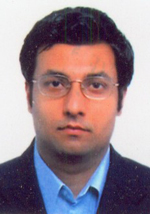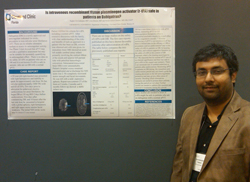Raghav Govindarajan
 The honor of membership into Sigma Xi spans disciplines and courses of research study.
The honor of membership into Sigma Xi spans disciplines and courses of research study.
Each month in the Sigma Xi Today section ofAmerican Scientistmagazine, and also on our website, we will be highlighting a different "Fellow Companion"—asking them about their work and what the honor of induction into Sigma Xi has meant for their career.
Today, we are excited to introduce Raghav Govindarajan M.D., the Chief Neurology Resident at the Cleveland Clinic in Florida. Govindarajan was educated in India before moving to the United States and will soon be starting a fellowship in neuromuscular studies at Washington University. Dr. Govindarajan is a dedicated researcher, with a passion for indiscipline.
Tell us about your educational background including your doctoral research, if applicable.ary scientific study and a true dedication to the honor of Sigma Xi.
I am currently the Chief Neurology Resident at The Cleveland Clinic Florida. I received my medical degree in India and I will be starting a neuromuscular fellowship at Washington University in St. Louis soon.
Do you have a particular teacher or professor who inspired your love of science? Why?
My biology teacher in high school was the first person who introduced the world of animal biology in general and human biology in particular. His way of explaining the concepts so that I could understand got me hooked, which finally led me to career in medicine. Now as a resident, I am inspired by several of my attending physicians—especially Dr.Salanga, who is our Chairman Emeritus; Dr. Salgado, who is my Program Director; and Dr. Galvez who is Chairman of our department. The quality that I admire most in them is their patience in listening and explaining the toughest concepts to me.
What is the focus of your current research?
I am currently working on the factors that predict positive repetitive nerve stimulation response in myasthenia gravis—a neuromuscular, autoimmune disorder that causes weakness in the voluntary muscles of the body.
Tell us about something we might see in our daily lives that directly correlates to your work.
As a neurologist, I interact with patients who are suffering from neurodegenerative diseases like Lou Gehrig’s disease and Alzheimer's. As such, I am constantly reminded of the advances we have made in their diagnosis and at the same time, the huge opportunities that are still present in their treatment and ultimately, their cure. It is this desire to help my patients that drives me to excel not only in patient care, but also in researching better ways to diagnose and treat these diseases.
Give us an example of how multi-disciplinary research directly contributed to your work.
As a neurologist involved in research, multidisciplinary approach is the key mantra for every research project that I undertake. For example, we recently completed a project which assessed the prevalence of infections in myasthenia gravis, where we had input from multiple departments including infectious disease, internal medicine and biostatics.
research, multidisciplinary approach is the key mantra for every research project that I undertake. For example, we recently completed a project which assessed the prevalence of infections in myasthenia gravis, where we had input from multiple departments including infectious disease, internal medicine and biostatics.
What are your thoughts on the future of STEM education?
STEM education is the corner stone of continuing scientific and technological advancement. For the US to remain competitive, greater emphasis has to be placed on making these programs more fun and interactive to school children of all ages.
Describe the patent/publishing experience—were there any bumps along the way for you?
Publishing is a long and arduous process. The time of conception to the completion of the first draft is part one of the greater process. Part two involves reading and re-reading the draft multiple times, making corrections, and responding to critics until the manuscript is accepted. Of course you will have bumps along the way when you submit a manuscript for peer review that is ultimately rejected, especially if you have put in lot of effort into it. The key here is persistence and being willing to write more revisions.
What has the honor of induction into Sigma Xi meant to you?
It is truly an honor and privilege to interact with some of the greatest minds around the world.
Has Sigma Xi helped further your career? If so, how? If you haven’t started your career yet, how do you believe Sigma Xi will serve you in the future?
Sigma Xi has offered me a window of opportunity to network with researchers and experts in multiple other fields. This has helped me gain a broader perspective, while also trying to answer my own research questions. Furthermore, it has given me a chance to collaborate with other researchers with similar ideas and backgrounds.
What books are you currently reading for pleasure?
I am currently reading No Easy Day and enjoying its fascinating details.
When you’re not working on your research, what do you do in your free time?
Most of my free time is spent reading the newspaper, watching movies, and sleeping.
What’s your favorite movie?
Men of Honor
What is your favorite motto?
“Do not follow where the path may lead. Go instead where there is no path and leave a trail.” -Harold R. McAlindon
What advice would you give a young researcher just starting out in your field?
Persist in your studies and find a good mentor who is ready to invest his or her time in your career.
Sigma Xi just celebrated its 125th year. What advances do you see in your field of research over the next 125 years?
I believe we will be able to find effective treatment, prevent the development of, or even possibly find a way to reverse the neurodegenerative changes of conditions like Alzheimer's, Lou Gehrig's and Parkinson's disease.